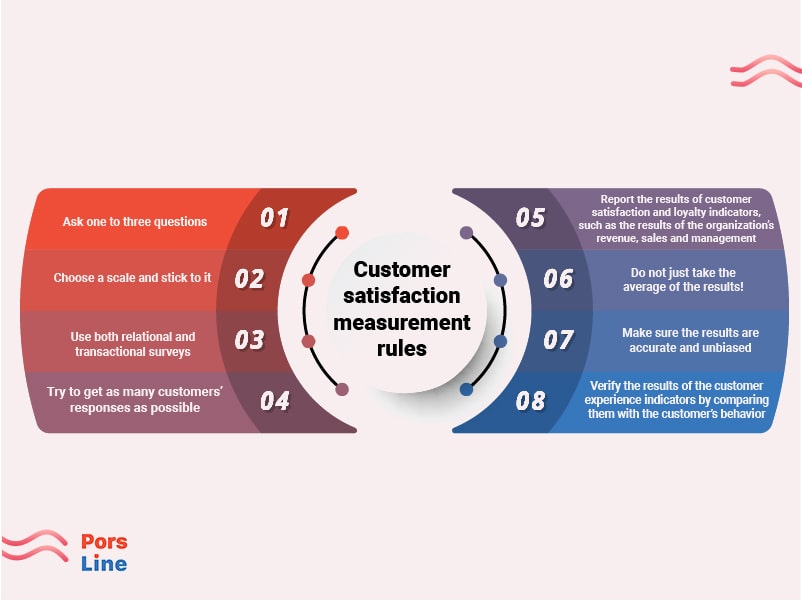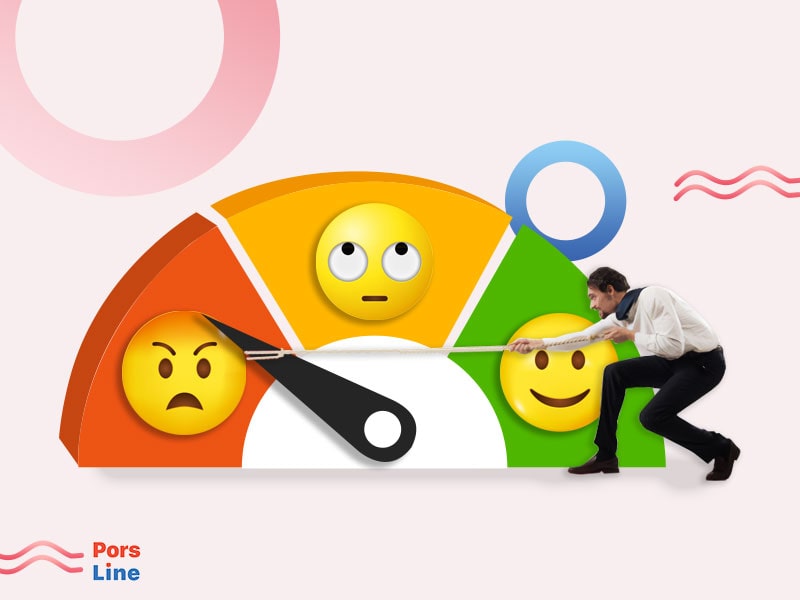The most up-to-date Customer Satisfaction measurement techniques you need to know

The first customer complaint recorded in human history dates back to 1750 BC when a text written on a clay tablet showed that the customer was not satisfied due to poor product quality, delay in delivery, and the seller’s failure to live up to the customer expectations.
3000 years after this complaint, in 1852, Marshall Field pointed out in his famous saying «The customer is always right», which he wrote in his shop, that companies should act responsibly and smartly towards their customers.
Nowadays, concepts such as Customer Satisfaction, Customer Loyalty, Customer Experience Management, and Customer Success have become an integral part of organizations. Their implementation should be based on three pillars: technology, process, and individuals so that the organization ultimately ensures the existence of satisfied, loyal, and successful customers.
In the post «Customer Satisfaction Measurement Tools and Importance», we presented a complete guide explaining the Customer Satisfaction concept and how to increase it. Now is the time to take a look at customer satisfaction measurement techniques, methods, standards, principles, and rules.
Criteria for Customer Satisfaction Measurement
Satisfaction is a reflection of the customer or consumer’s perception of the organization, product, or service. This feeling reflects the customer’s expectations of this organization, product, or service.
The dimensions of customer satisfaction differ from one organization to another and according to the factor taken into account.
The major dimensions that affect customer satisfaction can be categorized as:
The product: including product quality, life span, design, usability and performance.
The delivery: regarding timely delivery and delivery speed.
The staff and services: this includes the availability and knowledge of staff and representatives, the speed of problem-solving and complaint handling, the speed of answering questions, in addition to after-sales service, and the professional behavior of employees and representatives.
The price: including competitive pricing strategy and the price-quality approach that optimally prices a product according to its quality.
The organizational strategy: concerning the ease of communication, doing business, and transparency.
Getting customers’ feedback is the best way to measure Customer Satisfaction. And given the dimensions mentioned above, the questions you ultimately ask your customers depend on what you wish to know.
Disadvantages of traditional techniques in customer satisfaction measurement

Traditional customer satisfaction measurement methods have shortcomings and weaknesses, including:
- Most customer survey questionnaires are very lengthy, they waste customer time and make data analysis more complicated. Have you ever filled out a paper form with 20-30 questions next to the store cash register?
- It seems that these traditional surveys are more about producing a report than about learning and changing the behavior of employees in order to achieve customer loyalty.
- Many customer satisfaction surveys are anonymous. As a result, it is not possible to follow customers and close the feedback loop with each one of them.
- Survey questions are not designed with the intention of interacting with the customer in his/her own language.
- The response rate to customer satisfaction surveys is quite low, therefore the results cannot be reliable.
- Sometimes, the results are tampered with, such as a store branch or a customer support specialist asking the customer to give them a high score!
- They are conducted once a year, so naturally, they can not reflect the actual customer feedback.
Principles and rules of customer satisfaction measurement
Although the concept of a Net Promoter Score (NPS) or Customer Effort Score (CES) is simple, its implementation is not that easy.
In this post, we explain the principles and rules of measuring customer experience. These principles can shape the mindset of customer service or customer experience managers. But before that, we must not forget that customer segmentation is one of the most important basic tasks that you must do before you start identifying ways of customer satisfaction measurement.

The first principle: Ask between one and three questions
You can simply perform customer segmentation by asking the question “how likely you are to recommend our product/service/brand to your friends?”. Then ask a follow-up question for more insight and more detailed analysis. Avoid questions that do not provide you with useful information, waste customer time, and reduce response rates. After receiving the customer’s response, the manager or customer service and customer satisfaction experts should communicate with the customer via the phone, email, or in-person meeting, if necessary, in order to close the customer feedback loop.
The second principle: Choose a scale type and stick to it.
According to many studies, the “zero to ten” scale is the best scale for measuring customer loyalty, satisfaction, and effort. But the important thing is that every business should choose a scale to perform customer segmentation to divide customers into groups labeled with scores consistent with their behavior.
The third principle: Use a combination of relational surveys and transactional surveys.
Relational surveys give little valuable information to the units and employees who deal with the customer on a daily basis. These types of units, such as the support team or the call center and customer service staff, should be able to identify and address their weaknesses and solve them based on an instant survey. For example, Apple requests customer feedback shortly after a customer purchases in a store. In the case of B2B transactions, these types of surveys can be conducted daily or quarterly (every three months).
On the other hand, relational surveys are used more to compare with competitors and evaluate their performance. However, as in the case with transactional surveys, the relational surveys do not provide a practical perspective for solving fundamental problems.
The fourth principle: Try to get as many customers’ responses as possible
Obviously, not all customers provide you with feedback. So try to get feedback from the basic customer group, whom you want to turn into promoters. Also, target the groups from which your business profit the most, or any customer groups you think are most important to your business.
As a basic rule, if the customer satisfaction response rate is less than 65%, you need to adjust the process so that you can get reliable results and make the right decision based on their analysis. The common rates in the world’s leading businesses are between 70% and 95% whether in business-to-business (B2B) or business-to-customer (B2C).
The fifth principle: Report and manage the results of customer satisfaction and loyalty indicators, such as the revenue and sales results of the organization and its management.
Many organizations send surveys to their customers once a year with 40-50 questions and analyze and report the results after a month. It is clear that customer loyalty and customer satisfaction play a key role in the financial success of the organization. But you cannot build on the result/index value computed in one or two weeks of the year and focus on short-term financial indicators for another fifty weeks and anticipate customer satisfaction and loyalty to improve revenue and sales growth.
Customer experience indicators must be measured in a timely manner and at short intervals to provide the opportunity for continuous improvement of the organization. Also, The return on investment (ROI) must also be measurable for any initiative to improve the customer experience.
An organization that uses traditional customer satisfaction measurement methods through traditional once-a-year surveys cannot answer the question of how much customer satisfaction and loyalty play in the company’s revenue.
As a result, such companies cannot effectively put their human, financial, and time resources into the service of revenue and sales.
Getting feedback from customers must be done continuously and promptly. Also, keep in mind that only a few customers will answer more than just two questions.
The sixth principle: Do not just take the average of the results!
Imagine that police speed cameras measure the average speed of all the cars traveling on the highway. In this case, the situation would have always been good and no speeding violation would have been noticed. But these cameras are able to monitor the average and instantaneous speed of each car, so the police can go a step deeper in analyzing the data and detecting violations for each car.
Businesses have learned this in financial indicators for many years. In addition to reporting profits and revenues at the company level, they also study, analyze, and prepare reports at a more detailed level for each product line, geographic area, local stores, etc.
It is this level of more detailed analysis that helps teams and individuals make decisions and take corrective action.
When measuring customer experience indicators such as NPS, CES, CSAT and others, the company must analyze the collected data at a detailed level and not be satisfied with the values of these indicators at the company level as a whole. This is why a combination of relational surveys and transactional surveys should be included in the customer experience strategy.
The seventh principle: Make sure the results are correct and unbiased.
Receiving customer feedback and measuring indicators techniques should be designed so that the responses and respondents’ bias can be minimized. For example, it must be ensured that employees do not recommend the customer to give them a special score. Also, any customer, who was part of the statistical sample and did not answer the customer satisfaction measurement questions, should not be removed from the analysis of the results.
The eighth principle: Check the results of the customer experience indicators by comparing them with the customer’s behavior.
If based on the results of the NPS index, the customer turned out to be in the promoters group, he/she will adopt three distinct behaviors: buy more, recommend the product/brand/service to others, and take the time to provide constructive feedback to the company.
The organization should always check that scores for customer experience indicators match actual customer behavior to ensure that the feedback process is designed to be effective and unbiased.
International Indicators and methods used for customer satisfaction measurement
Customer Satisfaction Index (CSI) is an analytical tool for measuring the level of customer satisfaction with a product, service, or company. Thus, these customer satisfaction indicators help us discover the reason for customer satisfaction or dissatisfaction.
Customer satisfaction Measurement is very important for any company, as the collected data can be used to sell more products and services, increase the quality and value of the company’s offerings, and ensure the correct and effective implementation of economic operations. Moreover, customer satisfaction measurement models are powerful tools that will help you beat your competitors in the market.
In this section, we refer to the three main and important indicators of customer satisfaction so that you can adopt a suitable technique for customer satisfaction based on these models.
- European Customer Satisfaction Index (ECSI model): The European Customer Satisfaction Index model was created by several European experts based on a set of requirements. This model measures the relationship between seven components:
- Corporate image
- Customer expectations
- Perceived product quality
- Customer satisfaction index
- Perceived service quality
- Customer loyalty
- Perceived value
- American Customer Satisfaction Index (ACSI model): This index was designed in 1994 by Ph.D. Claes Fornell. This model measures three different indexes: customer expectations, perceived quality, and perceived value. These indexes measure all aspects of customer satisfaction.
- Swiss Index of Customer Satisfaction (SWICS model): It was first published in 1998. This model measures three factors: customer satisfaction, customer dialogue, and customer loyalty. The three factors exist in a causal relationship in which customer satisfaction affects customer dialogue and customer loyalty, while customer dialogue affects customer loyalty.
Modern and efficient customer satisfaction measurement techniques

If we want to put aside theoretical issues and examine most of the methods and techniques used for customer satisfaction measurement, we must use new and practical methods in this area.
Among the methods, tools, and forms of customer satisfaction measurement, the following can be mentioned:
1. Customer Satisfaction Survey
The standard method of collecting data on customer satisfaction is to use a customer satisfaction survey. You can use this type of survey to ask for your audience’s opinion through the following forms:
- In-program survey
- Survey after providing services
- Email survey
2. Customer Satisfaction Score
CSAT questionnaire allows you to ask your customers to score your product/service on scales from 1 to 3, from 1 to 5, or from 1 to 10.
3. Net Promoter Score Survey (NPS)
NPS survey shows how likely your customers are to recommend your product/service/brand to their friends, thus you can measure customer loyalty. In this survey, customers give you a score from 1 to 10.
A score from 1 to 6 means that the customer is dissatisfied and will not recommend your product/service/brand to anyone (Detractors).
If the score is from 7 to 8 – (Passives): the probability of recommending you is quite low.
But if you get a score from 9 to 10, it means that this customer is one of your brand promoters.
4. Customer Effort Score Survey (CES)
Indicators such as Net Promoters Score (NPS) or Customer Effort Score (CES) were designed to address the shortcomings of traditional customer satisfaction techniques. Any organization that implements NPS or CES scores does not simply calculate a number. The framework and process behind these indicators have led to their widespread acceptance by various companies. These companies manage customer feedback just as they measure and manage profits and financial indicators on a regular basis.
5. Following social networks and Social Listening
Social networks have a profound effect on building relationships between businesses and customers. Your customers share your brand name with the people closest to them. So it is best to hear what they have to say in this space.
To do this, you can use various tools such as Google Alert, Mention, or Social mention. Thanks to these tools, you can know whenever your name is mentioned in the virtual space and ask customers what they think of you.
6. Using the TGW or “Things Gone Wrong” method
This index is derived from the Lean Six Sigma approach. In this method, you can measure the number of customer complaints or “problems and mistakes”. The correct way to measure TGW is to use a Complaint Registration Survey.
Conclusion
Knowing the methods and techniques of measuring customer satisfaction helps you conduct customer satisfaction measurement surveys according to the right principles and rules so that in the end, using the right data, you get results that can be used to make fundamental and correct changes in the business which leads to increased customer satisfaction.




